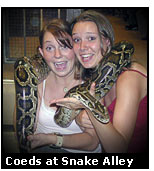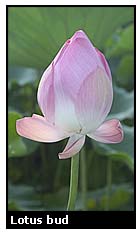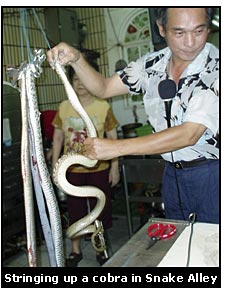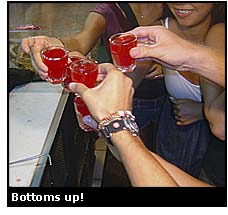|
– T A
I P E I –
September 6, 2004 – From
the moment we arrived in Taiwan, and even beforehand, there was a
constant buzz among the students about DRINKING THE SNAKE BLOOD. At
the logistical pre-port meeting the night before we docked in Keelung,
 the
ship's physician, "Dr. Milt," stood before the student
body, and as he always did before a port of call, he rattled off a
list of
health
warnings specific to the destination. Number one on his list that
evening was "Whatever you do, please don't drink the blood of
snakes."
He cited hepatitis and salmonella as possible complications. Only
an
idiot
would want
to
expose himself to either one. So naturally, at the first opportunity,
several groups of students headed for Snake Alley in Taipei to
drink the snake blood. We witnessed it firsthand. But I am getting
ahead of myself. the
ship's physician, "Dr. Milt," stood before the student
body, and as he always did before a port of call, he rattled off a
list of
health
warnings specific to the destination. Number one on his list that
evening was "Whatever you do, please don't drink the blood of
snakes."
He cited hepatitis and salmonella as possible complications. Only
an
idiot
would want
to
expose himself to either one. So naturally, at the first opportunity,
several groups of students headed for Snake Alley in Taipei to
drink the snake blood. We witnessed it firsthand. But I am getting
ahead of myself.
Taipei City Orientation
The first field program we signed up for in Taiwan was the "Taipei
City Orientation and Mongolian Barbecue." Since it provided an
opportunity to tour Taipei just hours after our arrival in Taiwan,
it was a popular
choice. Due to the large number of participants, people
were divided up into specific bus groups. We were relegated bus number
four, but our bus was the first to fill and the first to leave, which
proved advantageous in terms of beating the crowds.
 Taipei
was a 45 minute bus ride from Keelung. Our
first stop was the Chiang
Kai-shek Memorial Hall, a well-known landmark
in the center of Taipei. It is noted for its
grand scale
and architectural
splendor. Our second stop was the National
Museum of History, which
is located
right next to the Taipei Botanical Garden. My husband and
I skipped the Museum and we sneaked out to visit the garden with its
huge pools of
pink flowering
lotus. It was a wonderful diversion! Taipei
was a 45 minute bus ride from Keelung. Our
first stop was the Chiang
Kai-shek Memorial Hall, a well-known landmark
in the center of Taipei. It is noted for its
grand scale
and architectural
splendor. Our second stop was the National
Museum of History, which
is located
right next to the Taipei Botanical Garden. My husband and
I skipped the Museum and we sneaked out to visit the garden with its
huge pools of
pink flowering
lotus. It was a wonderful diversion!  We
made our way back to the Museum just as a thunderstorm hit, and lucky
for us, we still had plenty of time to view
the exhibits.
The third
stop
on the itinerary was
my favorite – Lungshan Temple. Built in 1740 to honor the
Goddess of Mercy, Lungshan is a perfect example of traditional
Chinese
temple architecture. It is one of Taiwan's oldest and most popular
temples – popular with both worshippers and tourists. It was
a fascinating place and I could have stayed there for many hours,
just taking photos. (See my Lungshan Photo
Gallery.) We
made our way back to the Museum just as a thunderstorm hit, and lucky
for us, we still had plenty of time to view
the exhibits.
The third
stop
on the itinerary was
my favorite – Lungshan Temple. Built in 1740 to honor the
Goddess of Mercy, Lungshan is a perfect example of traditional
Chinese
temple architecture. It is one of Taiwan's oldest and most popular
temples – popular with both worshippers and tourists. It was
a fascinating place and I could have stayed there for many hours,
just taking photos. (See my Lungshan Photo
Gallery.)
Unfortunately
we were scheduled for dinner at a Mongolian barbecue restaurant,
so we had to leave promptly. I wanted to linger. At the restaurant
we were asked to build our own dinner platters from
a huge selection of fresh uncooked meats, vegetables, oils, sauces,
and spices.
We then handed our creations over to a cadre of chefs who quickly
cooked them on a massive,
round
griddle. The theatrics were entertaining and the meal was pretty good
– but I still prefer authentic Chinese cuisine.
Welcome to Snake Alley
After dinner the buses took us over to Taipei's
infamous night market on Huahsi Street, just a half
block from Lungshan Temple and home to SNAKE ALLEY. The market area,
which has been renovated to make it more "suitable"
to foreigners, consists of noodle and fish restaurants, exotic and
not-so-exotic specialty
shops and scores of street vendors.
 Despite
the installation of bright lights, a paved walkway and an overhead
roof to keep out the rain, it still isn't hard to imagine
a time
when Snake Alley was a much darker and more sinister
place. As you might have guessed,
snakes and snake by-products are still hawked in Snake Alley,
although there are fewer of them. These days, sleepy boa constrictors
are brought forth and draped on the shoulders of tourists eager for
a
thrill – and
an outrageous picture
to send
home to the family. (Semester at Sea students couldn't get enough
of the boas.) But the big attraction at Snake Alley has always been,
and probably always will be, the cobras. Despite
the installation of bright lights, a paved walkway and an overhead
roof to keep out the rain, it still isn't hard to imagine
a time
when Snake Alley was a much darker and more sinister
place. As you might have guessed,
snakes and snake by-products are still hawked in Snake Alley,
although there are fewer of them. These days, sleepy boa constrictors
are brought forth and draped on the shoulders of tourists eager for
a
thrill – and
an outrageous picture
to send
home to the family. (Semester at Sea students couldn't get enough
of the boas.) But the big attraction at Snake Alley has always been,
and probably always will be, the cobras.
It you happen to be a cobra
in Snake Alley, you are sh*t out of luck. First, you are likely to
be taunted by your captor in front of a group of squirming bystanders.
Then you'll get hit on the head and strung up. The crowd will gasp
as your underbelly is slit open with a sharp knife. Your skin will
be peeled back and your heart exposed, still beating. Things only
get worse. Your heart is ripped out and placed on a table, where it
continues to beat. Then your main artery is cut. You bleed
out into a glass. The bile from your gall bladder is emptied
into another glass. Meanwhile, your heart is still beating
over on that table. By then you probably don't care anymore.
 But the
audience
does. They are anxious to drink your
body fluids. Chinese folklore holds that your essence has
curative properties, and can act to "strengthen masculinity." Your
blood or bile will be mixed with rice wine and served in shot glasses
– for a price, of course. The buyer may or may not be Chinese.
He probably isn't sick and it's doubtful he's in need of an aphrodisiac.
More than likely he's a westerner, a young tourist out to impress
his friends.
That was certainly the case with the large numbers of SAS students,
male and female, who were scrambling over each other for a chance
to chug some snake blood. I watched as one co-ed giddily
ran up and down the alley looking for Andy, the SAS videographer,
who happened to be taping in the vicinity. When she finally
found him, she grabbed him by the arm and squealed, "Come on, ya
gotta film us drinking snake blood!" He dutifully followed. But the
audience
does. They are anxious to drink your
body fluids. Chinese folklore holds that your essence has
curative properties, and can act to "strengthen masculinity." Your
blood or bile will be mixed with rice wine and served in shot glasses
– for a price, of course. The buyer may or may not be Chinese.
He probably isn't sick and it's doubtful he's in need of an aphrodisiac.
More than likely he's a westerner, a young tourist out to impress
his friends.
That was certainly the case with the large numbers of SAS students,
male and female, who were scrambling over each other for a chance
to chug some snake blood. I watched as one co-ed giddily
ran up and down the alley looking for Andy, the SAS videographer,
who happened to be taping in the vicinity. When she finally
found him, she grabbed him by the arm and squealed, "Come on, ya
gotta film us drinking snake blood!" He dutifully followed.
That night lots of the kids
drank snake blood. No telling how many. We didn't stick around to
watch. There were others things to see at the market besides snakes,
and we only had an hour to browse. We were then expected to
report back to our bus – on time – for the ride
back to Keelung. At the appointed hour, some of the students returned
to the buses with packages under their arms. They'd been shopping.
Others returned with their bellies full of snake blood. Clearly, Doctor
Milt's warning about hepatitis and salmonella had fallen on deaf ears.
Or had it? During
the long ride home Becky Houck, the faculty biologist, was tapped
on the shoulder by a student who was, apparently, having second thoughts.
"Surely it's safe to drink the snake blood," she said, "otherwise
the government wouldn't allow it." It was a question
more than a statement.
Hey Dorothy, I have news
for you. You're not in Kansas anymore.
Temple
Photo Gallery || Previous
Installment || Next installment
Archived comments (7) |
©2002-2008
by Ginnie Saunders. All rights are reserved. No part of this web
site
may be reproduced or transmitted in any form or by any means —
electronic or mechanical, including photocopying, recording, or by
any information storage or retrieval system — without written
permission from Ginnie
Saunders. To learn more about copyright issues on the web,
visit the Web Law
FAQ.
Ginnie.com, Inc.
PO Box 50314
Columbia, SC 29250
(803) 783-3169
www.ginnie.com
|


|

![]()



 the
ship's physician, "Dr. Milt," stood before the student
body, and as he always did before a port of call, he rattled off a
list of
health
warnings specific to the destination. Number one on his list that
evening was "Whatever you do, please don't drink the blood of
snakes."
He cited hepatitis and salmonella as possible complications. Only
an
idiot
would want
to
expose himself to either one. So naturally, at the first opportunity,
several groups of students headed for Snake Alley in Taipei to
drink the snake blood. We witnessed it firsthand. But I am getting
ahead of myself.
the
ship's physician, "Dr. Milt," stood before the student
body, and as he always did before a port of call, he rattled off a
list of
health
warnings specific to the destination. Number one on his list that
evening was "Whatever you do, please don't drink the blood of
snakes."
He cited hepatitis and salmonella as possible complications. Only
an
idiot
would want
to
expose himself to either one. So naturally, at the first opportunity,
several groups of students headed for Snake Alley in Taipei to
drink the snake blood. We witnessed it firsthand. But I am getting
ahead of myself. Taipei
was a 45 minute bus ride from Keelung. Our
first stop was the
Taipei
was a 45 minute bus ride from Keelung. Our
first stop was the  We
made our way back to the Museum just as a thunderstorm hit, and lucky
for us, we still had plenty of time to view
the exhibits.
The third
stop
on the itinerary was
my favorite – Lungshan Temple. Built in 1740 to honor the
Goddess of Mercy, Lungshan is a perfect example of traditional
Chinese
temple architecture. It is one of Taiwan's oldest and most popular
temples – popular with both worshippers and tourists. It was
a fascinating place and I could have stayed there for many hours,
just taking photos. (See my
We
made our way back to the Museum just as a thunderstorm hit, and lucky
for us, we still had plenty of time to view
the exhibits.
The third
stop
on the itinerary was
my favorite – Lungshan Temple. Built in 1740 to honor the
Goddess of Mercy, Lungshan is a perfect example of traditional
Chinese
temple architecture. It is one of Taiwan's oldest and most popular
temples – popular with both worshippers and tourists. It was
a fascinating place and I could have stayed there for many hours,
just taking photos. (See my  Despite
the installation of bright lights, a paved walkway and an overhead
roof to keep out the rain, it still isn't hard to imagine
a time
when Snake Alley was a much darker and more sinister
place. As you might have guessed,
snakes and snake by-products are still hawked in Snake Alley,
although there are fewer of them. These days, sleepy boa constrictors
are brought forth and draped on the shoulders of tourists eager for
a
thrill – and
an outrageous picture
to send
home to the family. (Semester at Sea students couldn't get enough
of the boas.) But the big attraction at Snake Alley has always been,
and probably always will be, the cobras.
Despite
the installation of bright lights, a paved walkway and an overhead
roof to keep out the rain, it still isn't hard to imagine
a time
when Snake Alley was a much darker and more sinister
place. As you might have guessed,
snakes and snake by-products are still hawked in Snake Alley,
although there are fewer of them. These days, sleepy boa constrictors
are brought forth and draped on the shoulders of tourists eager for
a
thrill – and
an outrageous picture
to send
home to the family. (Semester at Sea students couldn't get enough
of the boas.) But the big attraction at Snake Alley has always been,
and probably always will be, the cobras.  But the
audience
does. They are anxious to drink your
body fluids. Chinese folklore holds that your essence has
curative properties, and can act to "strengthen masculinity." Your
blood or bile will be mixed with rice wine and served in shot glasses
– for a price, of course. The buyer may or may not be Chinese.
He probably isn't sick and it's doubtful he's in need of an aphrodisiac.
More than likely he's a westerner, a young tourist out to impress
his friends.
That was certainly the case with the large numbers of SAS students,
male and female, who were scrambling over each other for a chance
to chug some snake blood. I watched as one co-ed giddily
ran up and down the alley looking for Andy, the SAS videographer,
who happened to be taping in the vicinity. When she finally
found him, she grabbed him by the arm and squealed, "Come on, ya
gotta film us drinking snake blood!" He dutifully followed.
But the
audience
does. They are anxious to drink your
body fluids. Chinese folklore holds that your essence has
curative properties, and can act to "strengthen masculinity." Your
blood or bile will be mixed with rice wine and served in shot glasses
– for a price, of course. The buyer may or may not be Chinese.
He probably isn't sick and it's doubtful he's in need of an aphrodisiac.
More than likely he's a westerner, a young tourist out to impress
his friends.
That was certainly the case with the large numbers of SAS students,
male and female, who were scrambling over each other for a chance
to chug some snake blood. I watched as one co-ed giddily
ran up and down the alley looking for Andy, the SAS videographer,
who happened to be taping in the vicinity. When she finally
found him, she grabbed him by the arm and squealed, "Come on, ya
gotta film us drinking snake blood!" He dutifully followed.